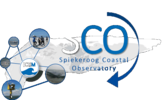Contact
Spiekeroog Coastal Observatory (SCO)
Visitors' address
Past Projects
Coastal Ocean Darkening
| Summary | The availability of light in the water column is essential for the life of marine organisms. Water color allows conclusions to be drawn about water transparency and light availability. Several studies show that there is a global decline in phytoplankton or that there are regionally different developments of ocean color towards bluish or greenish. Coastal areas and their changes with respect to light availability in the water are not considered much in the studies mentioned above. Coastal waters are sensitive to changes in abiotic conditions, which have not been adequately addressed with respect to spectral light observations. Coastal Ocean Darkening examines the past and future 100 years for potential reductions in light availability in coastal waters, through a combination of historical observations, hyperspectral measurements, biodiversity studies, and model scenarios. Radiometer data at the Time-Series Station Spiekeroog provide measurements of apparent optical properties from which water transparency and color can be inferred. This allows a detailed investigation of possible trends in these parameters in the Wadden Sea, where changes in environmental conditions are of particular interest with respect to biodiversity and primary productivity.
|
| Period | 2016 - 2020 |
| Contact Person | |
| Funding Agency | Lower-Saxony Ministry of Research and Culture |
| Website | |
Macroplastics Pollution in the Southern North Sea - Sources, Pathways and Abatement Strategies
| Summary | The project Macroplastics addressed the issue of marine plastic pollution. The project aimed to provide a solid scientific basis for understanding the current and future distribution patterns of plastic debris along the coasts and islands of the northwest German coastlines, to clearly identify the polluters, and to develop effective abatement strategies. To achieve this goal, an interdisciplinary consortium consisting of physical oceanographers, geoecologists and environmental planners at the University of Oldenburg collaborated in a joint project funded by the Lower Saxony Ministry of Science and Culture. The aim of the project within the working group Marine Sensor Systems was to understand the mechanisms that lead to the landing of plastic waste on beaches and coasts and to investigate possible transport pathways of plastic litter in the southern North Sea. For this purpose, experiments with drift buoys were carried out and oceanographic and meteorological parameters were recorded during various measurement campaigns. Furthermore, various experiments were conducted on research cruises with the research vessel Heinke to quantitatively investigate the distribution of macroscopic plastic waste in the southern North Sea.
|
| Period | 2016 - 2020 |
| Contact person | |
| Funding Agency | Lower-Saxony Ministry of Research and Culture |
| Website | |
Assessment of ground- and porewater-derived nutrient fluxes into the German North Sea -
Is there a “Barrier Island Mass effect” (BIME)
| Summary | Groundwater below the island of Spiekeroog flows continuously towards the sea and discharged in the intertidal zone. Since there are no rivers on Spiekeroog, nutrient input to the sea occurs via a subterranean estuary. The aim of the interdisciplinary project BIME was to gain a better understanding of the subterranean estuaries at the North beach on Spiekeroog. In particular, a central component of BIME was the investigation of the spatial and temporal variability of the exchange processes between groundwater and seawater. These complex relationships were investigated by BIME as an interdisciplinary team of chemists, biologists, hydrologists and engineers in close cooperation with the water associations and the national park administration.
|
| Period | 2016 - 2021 |
| Contact Person | Dr. Hannelore Waska, Prof. Dr. Thorsten Dittmar |
| Funding Agency | Lower-Saxony Ministry of Research and Culture |
| Website | |
Biodiversity Ecosystem Functioning across marine and terrestrial ecosystems (BEFmate)
| Summary | The main objective of the project BEFmate was to explore the understanding of the relationships between biodiversity and ecosystem functioning across the interfaces between marine and terrestrial ecosystems. For this purpose, twelve experimental islands were established in the back-barrier tidal flats of the island of Spiekeroog in 2014. Furthermore, experimental plots were established in the nearby salt marsh to support the research. Within the project, the description of the functional consequences of loss of biodiversity over the entire "tree of life" and from genes to ecosystems should be further investigated. Accordingly, the project should not only focus on one model organism. Further aims of the project were to fuse ecological and evolutionary aspects of functional biodiversity research; to synthesize BEF-research with ecological theory on stoichiometry, allometry, and food web structure; and to understand how neutral and dispersal processes affect BEF-relationships in space and time. The BEFmate project subsequently gave rise to the research unit DynaCom.
|
| Period | 2014 - 2017 |
| Contact Person | Prof. Dr. Helmut Hillebrand |
| Funding Agency | Lower-Saxony Ministry of Research and Culture |
| Website | uol.de/icbm/verbundprojekte/abgeschlossene-projekte/befmate |
BioGeoChemistry of tidal flats
| Summary | The aim of the research group BioGeoChemistry of tidal flats was to gain a fundamental understanding of important processes in the Wadden Sea system. For this purpose, sediments and hydrodynamic conditions were investigated to determine the influence of biogeochemical processes in the tidal flat sediments and at the sediment-water interface. This should lead to the development of a mathematical ecosystem model, which should also be applicable to other tidal flat areas. Within the framework of the Wadden Sea Research Group, the Time-Series Station Spiekeroog was established in 2002, which is considered as basis of the Spiekeroog Coastal Observatory.
|
| Period | 2002 - 2009 |
| Contact Person | |
| Funding Agency | German Research Foundation (DFG) |
| Website | |

